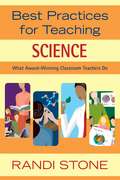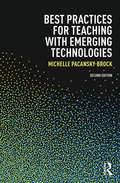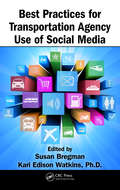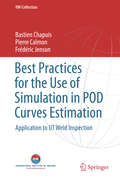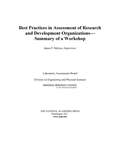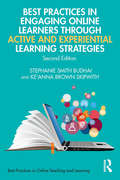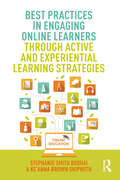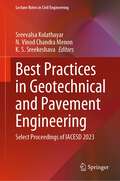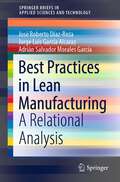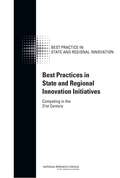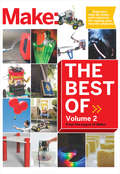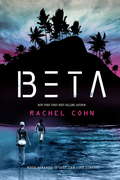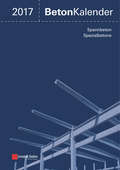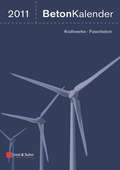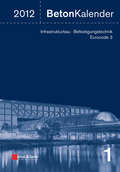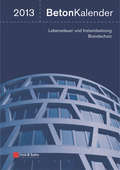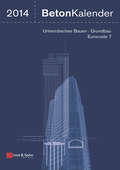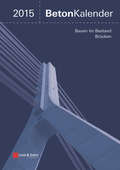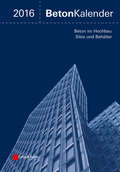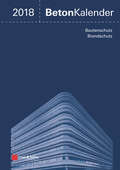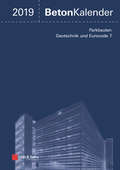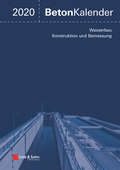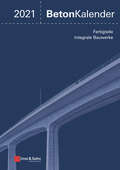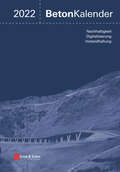- Table View
- List View
Best Practices for Teaching Science: What Award-Winning Classroom Teachers Do
by Randi StoneLet Randi Stone and her award-winning teachers demonstrate tried-and-tested best practices for teaching science in diverse elementary, middle, and high school classrooms. Linked to companion volumes for teaching writing and mathematics, this resource for new and veteran educators helps build student confidence and success through innovative approaches for raising student achievement in science, such as: Expeditionary learning, technology and music, and independent research study Model lessons in environmental studies and real-world science Inquiry-based strategies using robotics, rockets, straw-bale greenhouses, "Project Dracula," "Making Microbes Fun," and more! With engaging activities weaving through science fact and fiction to lead learners on intriguing journeys of discovery, this guide is sure to fascinate and inspire both you and your students!
Best Practices for Teaching with Emerging Technologies (Best Practices in Online Teaching and Learning)
by Michelle Pacansky-BrockAs social media and Web 2.0 technologies continue to transform the learning trends and preferences of students, educators need to understand the applicability of these new tools in all types of learning environments. The second edition of Best Practices for Teaching with Emerging Technologies provides new and experienced instructors with practical examples of how low-cost and free technologies can be used to support student learning as well as best practices for integrating web-based tools into a course management system and managing student privacy in a Web 2.0 environment. "Showcase" spotlights throughout exemplify how the tools described in the book are already being used effectively in educational settings. This thoroughly revised second edition includes: a new chapter that explores how and why faculty are using the public web and open educational resources in place of a learning management system (LMS) and an expensive textbook additional tips and showcases in every chapter that illustrate faculty use of particular technologies the inclusion of new tools to replace technologies that no longer exist a revamped website featuring expanded online resources. This practical, easy-to-use guide will serve the needs of educators seeking to refresh or transform their instruction. Readers will be rewarded with an ample yet manageable collection of proven emerging technologies that can be leveraged for generating content, enhancing communications with and between students, and cultivating participatory, student-centered learning activities.
Best Practices for Transportation Agency Use of Social Media
by Susan Bregman Kari Edison WatkinsTimely updates, increased citizen engagement, and more effective marketing are just a few of the reasons transportation agencies have already started to adopt social media networking tools. Best Practices for Transportation Agency Use of Social Media offers real-world advice for planning and implementing social media from leading government practit
Best Practices for the Use of Simulation in POD Curves Estimation: Application to UT Weld Inspection (IIW Collection)
by Bastien Chapuis Pierre Calmon Frédéric JensonThis book provides best-practice guidance and practical recommendations on the use of numerical simulation for probability of detection (POD) curve estimation in the study of non-destructive testing reliability. It focuses on ultrasonic testing (UT) weld inspection but many of the principles can be applied to a broader range of techniques and situations. The first part lists and briefly describes the principal documents that establish the recommended statistical framework adapted for POD curve estimation. It also presents the most important initiatives on the model assisted probability of detection (MAPOD) approach in recent years. The second part provides details of the advantages and limitations of the simulation in this context. The third part then describes the prerequisites for the use of simulation (validation of the software, expertise of the user), and the fourth and main part offers the methodology and guidance as well as possible applications for using POD curves determined using simulation.
Best Practices in Assessment of Research and Development Organizations
by National Research Council Division on Engineering and Physical Sciences Laboratory Assessments BoardThe National Institute of Standards and Technology (NIST)--recognizing that information and insights gained through continual examination of practices for organizational assessment are useful for decision makers at organizations across the deferral, industrial, academic, and national laboratory sectors-recently requested that the National Research Council (NRC) organize a panel to review best practices in assessment of research and development (R&D) organizations. In response, the NRC established the Panel for Review of Best Practices in Assessment of Research and Development Organizations. The panel was charged to consider means of assessing the following in a manner that satisfies the requirements of NIST to perform effective assessments but also identifies assessment methods that can be applied selectively to other R&D organizations. These methods include: technical merit and quality of the science and engineering work, the adequacy of the resources available to support high-quality work, the effectiveness of the agency's delivery of the services and products required to fulfill its goals, the degree to which the agency's current and planned R&D portfolio supports its mission, as well as the agency's flexibility to respond to changing economic, political, social and technological contexts. As one means of data gathering, among others that the panel is performing toward development of a final report of its findings, the panel organized a planning committee for a workshop on best practices in assessment of R&D organizations. Best Practices in Assessment of Research and Development Organizations: Summary of a Workshop reviews the workshop conducted at the Keck Center of the National Academies in Washington, D.C., on March 19, 2012.
Best Practices in Engaging Online Learners Through Active and Experiential Learning Strategies (Best Practices in Online Teaching and Learning)
by Stephanie Smith Budhai Ke'Anna Brown SkipwithBest Practices in Engaging Online Learners Through Active and Experiential Learning Strategies, Second Edition, is a practical guide for all instructors, instructional designers, and online learning administrators designing, developing, teaching, and leading online, hybrid and blended learning courses and programs, who seek to provide supportive, engaging, and interactive learner experiences. This book explores the integration of active and experiential learning approaches and activities including simulations, gamification, social media integration, project-based learning, scenario-based learning, virtual tours, and online micro-credentialing as they relate to the development of authentic skill-building, communication, problem-solving, and critical-thinking skills in learners. New and emerging learning technologies of virtual and augmented reality along with artificial intelligence are included in this updated edition with examples of how instructors can actively use them in online courses to engage learners in experiential experiences. Readers will find guidelines for the development of participatory and peer-learning, competency-based learning, field-based experiences, clinical experiences, and service-learning opportunities in the online classroom. In addition, the authors provide effective learning strategies, discipline-specific examples, templates, and additional resources that align learner engagement with assessment practices and course outcomes.
Best Practices in Engaging Online Learners Through Active and Experiential Learning Strategies (Best Practices in Online Teaching and Learning)
by Stephanie Smith Budhai Ke'Anna SkipwithBest Practices in Engaging Online Learners Through Active and Experiential Learning Strategies is a practical guide for all instructors and instructional designers working in online or blended learning environments who want to provide a supportive, engaging, and interactive learner experience. This book explores the integration of active and experiential learning approaches and activities including gamification, social media integration, and project- and scenario-based learning, as they relate to the development of authentic skill-building, communication, problem-solving, and critical-thinking skills in learners. Readers will find guidelines for the development of participatory peer-learning, cooperative education, and service learning opportunities in the online classroom. In addition, the authors provide effective learning strategies, resources, and tools that align learner engagement with course outcomes.
Best Practices in Geotechnical and Pavement Engineering: Select Proceedings of IACESD 2023 (Lecture Notes in Civil Engineering #449)
by Sreevalsa Kolathayar N. Vinod Chandra Menon K. S. SreekeshavaThis book presents select proceedings of the International Conference on Interdisciplinary Approaches in Civil Engineering for Sustainable Development (IACESD 2023). The topics covered include emerging practices in geotechnical engineering and pavement, innovative approaches, and technologies to enhance the durability, sustainability, and performance of infrastructure, geosynthetics, geotechnical monitoring systems, and ground improvement techniques to address soil stability, settlement, and liquefaction issues. This book is useful for researchers and professionals’ geotechnical engineering.
Best Practices in Lean Manufacturing: A Relational Analysis (SpringerBriefs in Applied Sciences and Technology)
by Jorge Luis García Alcaraz José Roberto Díaz-Reza Adrián Salvador Morales GarcíaThis book reports four structural equation models (SEM) for quantifying the relationship between the most important lean manufacturing (LM) practices applied to the manufacturing industry. The SEMs are evaluated using 220 responses to a survey applied to manufacturing companies applying LM principles in the production system and are related to: distribution and maintenance, production process and quality system, supply chain and quality, and an integrator model. The findings identify the most important activities for every LM practices and how they are related. These relationship’ values will help administrators, managers, engineers to focus their efforts on these most important activities, facilitating the decision-making process.
Best Practices in State and Regional Innovation Initiatives
by Charles W. WessnerMost of the policy discussion about stimulating innovation has focused on the federal level. This study focuses on the significant activity at the state level, with the goal of improving the public's understanding of key policy strategies and exemplary practices. Based on a series of workshops and conferences that brought together policymakers along with leaders of industry and academia in a select number of states, the study highlights a rich variety of policy initiatives underway at the state and regional level to foster knowledge based growth and employment. Perhaps what distinguishes this effort at the state level is most of all the high degree of pragmatism. Operating out of necessity, innovation policies at the state level often involve taking advantage of existing resources and recombining them in new ways, forging innovative partnerships among universities, industry and government organizations, growing the skill base, and investing in the infrastructure to develop new technologies and new industries. Many of these initiatives are being guided by leaders from the private sector and universities. The objective of Best Practices in State and Regional Innovation Initiatives: Competing in the 21st Century is not to do an empirical review of the inputs and outputs of various state programs. Nor is it to evaluate which programs are superior. Indeed, some of the notable successes, such as the Albany nanotechnology cluster, represent a leap of leadership, investment, and sustained commitment that has had remarkable results in an industry that is actively pursued by many countries. The study's goal is to illustrate the approaches taken by a variety of highly diverse states as they confront the increasing challenges of global competition for the industries and jobs of today and tomorrow.
Best of Make: 65 Projects and Skill Builders from the Pages of Make: (Volume #2)
by The Editors of Make:After ten years, Make: has become one of most celebrated magazines to hit the newsstands, and certainly one of the hottest reads. If you're just catching on to the Maker Movement and wonder what you've missed, this book contains the best projects and articles from the magazine. Find out what keeps Makers coming back to Make: with this assortment of DIY projects and articles selected by Make:'s editors. Learn to:Outfit your workshop and make some must-have toolsBuild electronic projects from actuators to antennaeMake things with Arduino and Raspberry PiCreate drones and robotsBuild noisemaking projects and musical instrumentsAugment your photo and video capabilitiesMake your own food, soap, ink, and more
Best of the Beast! The Mr. Beast Unofficial Guide
by ScholasticFind out everything there is to know about Mr. Beast, the undisputed king of the internet! Full of photos, interviews, and more! 100% unofficial!If you've ever wondered how the much-loved megastar Mr. Beast became one of the BIGGEST and most popular YouTubers on the planet, then this is the book for you!Packed with fantastic facts, and insider info, this book has everything you need to know about the digital superstar!
Beta: A Beta Novel (A Beta Novel)
by Rachel CohnElysia was born without a soul, her only purpose to serve the wealthy inhabitants of Io, an island paradise. But sensations are clouding her mind...anger...loneliness???love. Before long, Elysia learns that she is a Defect. And If any human on the island discovers the truth, it will cost her her life.
Beton Kalender 2017: Schwerpunkte: Spannbeton, Spezialbetone (Beton-Kalender (VCH) *)
by Konrad Bergmeister Frank Fingerloos Johann-Dietrich WörnerBeton unterliegt einem Wandel der Anforderungen und entwickelt selbst Innovationskraft mit Auswirkungen auf Gestaltung bis hin zur Baustellenlogistik. Die Entwicklung von hochfesten, ultrahochfesten und selbstverdichtenden Betonen, die gestiegenen Qualitätsanforderungen und die zu erwartende Knappheit natürlicher Gesteinskörnungen setzen neue Anforderungsmaßstäbe an Entwurfskonzepte. Die Anforderungen an die Dauerhaftigkeit von Beton zielen insbesondere auf eine gute Homogenität und auf eine relativ hohe Dichte. Dieses Ziel kann nur im Zusammenwirken von Konstruktion, Statik, Herstellung, Transport, Förderung, Verarbeitung und Nachbehandlung erreicht werden. Die Anforderungen an die Wirtschaftlichkeit von Betontragwerken können durch Optimierung von Prozessen und Automatisierung in der Baulogistik erfüllt werden - der Bauablauf im Jahr 2017 unterscheidet sich erheblich von Baustellen vor 50 oder gar 100 Jahren. Immer höhere erzielbare Festigkeiten ermöglichen schlankere Bauteile. Auch die Gestaltbarkeit von Tragwerken wird vielseitiger, diese erfordert aber gleichzeitig eine leichte Verarbeitbarkeit. Vor diesem Hintergrund enthält der Beton-Kalender 2017 eine Reihe von Beiträgen über Betonherstellung, aktuelle Produkterweiterungen sowie verschiedene Anwendungen von Spezialbetonen und deren Qualitätssicherung sowie erstmalig über die bautechnische Anwendung von tragenden Kunststoffbauteilen. Außerdem wurde der aktuelle Wissensstand über Spannbeton aufgearbeitet. In bewährter Weise werden aktuelle europäische und nationale Normen in konsolidierten Kurzfassungen fortgeführt. Der Beton-Kalender 2017 ist eine besondere Fundgrube für Ingenieure in Planungsbüros und in der Bauindustrie.
Beton-Kalender 2011: Kraftwerke, Faserbeton (Beton-Kalender (VCH) *)
by Konrad Bergmeister Frank Fingerloos Johann-Dietrich Wörner Herausgegeben Von Kraftwerke FaserbetonStructures for power generation are being designed and built at local, regional and international scales - the title provides the necessary knowledge for planning and design. Also: fibre-reinforced concretes incl. the March 10 DAfStb guideline on steel fibre reinforced concrete.
Beton-Kalender 2012: Schwerpunkte - Infrastrukturbau, Befestigungstechnik, Eurocode 2 (Beton-Kalender (VCH) *)
by Frank Fingerloos Berlin Johann-Dietrich Wörner Darmstadt Konrad Bergmeister WienStructures for infrastructure projects involving road and rail are being built locally, regionally and internationally - the Concrete Yearbook provides the necessary know-how for design and planning. Also: Fastenings, EC2 with NA and comments.
Beton-Kalender 2013: Lebensdauer und Instandsetzung-Behalter (Beton-Kalender (VCH) *)
by Konrad Bergmeister Frank Fingerloos Johann-Dietrich WörnerThe durable and economic design of structures today includes not only the verification of structural stability but also of the serviceability for the planned lifetime including the consideration of time-dependent actions and material properties of a structure.
Beton-Kalender 2014: Schwerpunkte: Unterirdisches Bauen - Grundbau - Eurocode 7 (Beton-Kalender (VCH) *)
by Herausgegeben Von Konrad Bergmeister Wein Frank Fingerloos Berlin Johann-Dietrich Wörner DarmstadtUnderground construction and foundations are very complex and expensive today, particularly in inner cities. In order to provide a quick overview of the interfaces and the necessary dialogue among qualified engineers in modern design and construction, the entire range of disciplines and specialisations involved are described. The latest types of foundations and construction methods in general building are extensively described. Particular attention is paid to the highly non-linear and complex holistic behavior of the system ground-structure and the interaction between the verification of serviceability of the foundation and the limit state of load-bearing capacity in the structure above. Excavations are required for almost all construction projects, from pipe laying to extensive building projects between existing buildings. The essential calculation methods and construction processes are explained here, updated from EAB 2012.
Beton-Kalender 2015 Schwerpunkte: Bauen im Bestand Brücken (Beton-Kalender (VCH) *)
by Ernst & SohnBridge building and refurbishment are important challenges at the moment. The book includes a commented short version of the DIN bridge building handbook. Also: structural design for refurbishment and repair of concrete structures, ballastless track, building dynamics.
Beton-Kalender 2016: Schwerpunkte: Beton im Hochbau, Silos und Behälter (Beton-Kalender (VCH) *)
by Ernst & SohnArticles about the classic core areas of structural engineering, for example precast elements, composite floors, multi-functional slabs, economic reinforcement in building and industrial and agricultural silo construction. Also: energy storage, fire protection.
Beton-Kalender 2018: Schwerpunkte: Instandsetzung (Beton-Kalender (VCH) *)
by Konrad Bergmeister Frank Fingerloos Johann-Dietrich WörnerDer neue Beton-Kalender 2018 mit den Schwerpunkten Bautenschutz und Brandschutz bietet eine solide Arbeitsgrundlage und ein topaktuelles und verlässliches Nachschlagewerk für die fehlerfreie Planung dauerhafter Betonkonstruktionen. Dabei geht es um den Schutz vor Betonschäden und den Schutz der Bewehrung, um die Sicherstellung der Gebrauchstauglichkeit, sowie um die Abwehr von Gefahren für Füllgüter oder für die Umwelt. Das Buch stellt den neuesten Stand der Technik der Oberflächenschutzsysteme für verschiedene Anforderungen dar und enthält praxisgerechte Hinweise für die Planung wirtschaftlicher Betonkonstruktionen mit minimalen Instandsetzungskosten und nachhaltig wirksamer Schutzmaßnahmen im Bestand.Eine wesentliche Innovationskraft der Betonbauweise besteht in neuen Betonen und in der immer besseren Verarbeitung und Qualitätssicherung, wie z. B. mit dem neuen System der Frischbetonverbundfolie. Diese bietet für wasserundurchlässige Betonbauwerke eine zusätzliche Sicherheit bei besonderen und schwierigen Randbedingungen oder bei hohen Nutzungsanforderungen. Ihre Anwendung dient der Abdichtung erdberührter Bauteile, aber auch z. B. zum Verkleben von Wärmedämmung auf Außenwänden. Zusätzlich werden aktuelle Erläuterungen zur Neuausgabe der DAfStb-Richtlinie WU-Beton aus erster Hand gegeben.Ein Kapitel befasst sich auf aktuellem Stand mit der Bemessung der Schalungssysteme aufgrund von Frischbetondruck. Dabei stellen geneigte oder gekrümmte Betonbauteile hohe Anforderungen an die Schalungstechnik und die Bauausführung. Ein neues Ingenieurmodell zur Betrachtung der Standsicherheit wird vorgestellt.Zum Schwerpunkt Brandschutz wird das Verhalten von Beton unter Brandbeanspruchung grundlegend zusammengefasst. Außerdem werden ausführliche Hintergrunderläuterungen zum konstruktiven baulichen Brandschutz gegeben. Für die "Heißbemessung" dient eine zusammenfassende Darstellung der wichtigsten bzw. gebräuchlichsten Bemessungstabellen aus DIN EN 1992-1-2 mit NA und aus DIN 4102-4/ DIN 4102-22 (Tabellenverfahren) einschließlich Beispielen dem schnellen Zugriff in der Praxis.Für die tägliche Berechnungs- und Bemessungspraxis wird die nichtlineare Berechnung von Stahlbetonbauteilen und -tragwerken mit Hilfe der FE-Methode übersichtlich aufbereitet. Dabei wird besonderes Gewicht auf praxistaugliche Hinweise für die Vorbereitung und Durchführung solcher Berechnungen gelegt.Die Digitalisierung und der damit verbundene technologische Fortschritt ermöglichen die Einführung von innovativen, digital gestützten Methoden und Werkzeugen. Vor diesem Hintergrund wird bereits seit einigen Jahren Building Information Modeling (BIM) als neue Arbeitsmethodik angewandt. Es werden die mit der Einführung und Nutzung von BIM verbundenen Themenbereiche und Prozesse bezüglich Technologie, Einbindung in das Rechtsgefüge, Standardisierung und Zusammenarbeit übersichtlich dargestellt. Praxisbeispiele und konkrete Projekterfahrungen verdeutlichen die nutzbringende Anwendung.Untersuchungen zur Ermittlung des Ermüdungswiderstandes von Betonbauteilen unter sehr hohen Lastwechselzahlen führten zu neuen Erkenntnissen über die Schädigungsentwicklung - die Thematik wird unter Einbeziehung der Modelle und Bemessungskonzepte grundlegend behandelt. Der Beton-Kalender 2018 ist wiederum eine besondere Fundgrube für Ingenieure in Planungsbüros und in der Bauindustrie.
Beton-Kalender 2019 - Schwerpunkte: Parkbauten; Geotechnik und Eurocode 7 (Beton-Kalender (VCH) *)
by Konrad Bergmeister Frank Fingerloos Johann-Dietrich WörnerDer neue Beton-Kalender 2019 mit den Schwerpunkten Parkbauten sowie Geotechnik und EC 7 bietet eine solide Arbeitsgrundlage und ein topaktuelles und verlässliches Nachschlagewerk für die fehlerfreie Planung dauerhafter Betonkonstruktionen. Zahlreiche Parkhäuser und Tiefgaragen werden im Rahmen des Ausbaus der Verkehrsinfrastruktur und im innerstädtischen Bauen errichtet. Hierbei sind viele Besonderheiten in Bezug auf Funktionalität und Dauerhaftigkeit zu beachten, die gerade in der Planung ein hohes Maß an speziellem Wissen erfordern. Die relevanten Regelwerke für Deutschland, Österreich und die Schweiz werden in dieser Ausgabe vorgestellt und erläutert. Vertiefende Beiträge behandeln die Instandsetzung von Tiefgaragen und Parkhäusern, den chemischen Angriff auf Beton und den kathodischen Korrosionsschutz. Die Abdichtungen bei unterirdischen Bauwerken werden in einem aktualisierten Beitrag gesondert behandelt. Für Entwurf, Berechnung und Bemessung in der Geotechnik werden Erläuterungen und Hintergründe zum Eurocode 7 auf aktuellem Stand gegeben. Flachgründungen und Pfahlgründungen werden dabei mit zahlriechen Beispielen behandelt. Außerdem ist zur Vervollständigung neben den Gründungen an Land ein umfassendes Kapitel den marinen Gründungsbauwerken gewidmet. In bewährter Weise wird die Eurocode-Kommentierung in Kurzfassungen für einfache Anwendungsfälle und die schnelle Orientierung fortgeführt: passend zum Schwerpunkt ist DIN EN 1997 Teil 1 "Entwurf, Berechnung und Bemessung in der Geotechnik" (Eurocode 7) mit den zugehörigen Nationalen Anwendungsdokumenten in konsolidierter Form und auf aktuellem Stand in dieser Ausgabe enthalten. Die Innovationskraft der Betonbauweise muss sich auch bei der Gewichtsminimierung von tragenden Betonbauteilen beweisen. Hierzu wird die Technologie des Gradientenbetons vorgestellt. Dieser Ansatz basiert auf der bewussten Gestaltung des Bauteilinnern mit dem Ziel einer Homogenisierung der Spannungsfelder und damit verbunden einer signifikanten Masseneinsparung unter der Berücksichtigung einer rezyklierfähigen Bauweise. Der Beton-Kalender 2019 ist wiederum eine besondere Fundgrube für Ingenieure in Planungsbüros und in der Bauindustrie.
Beton-Kalender 2020: Schwerpunkte: Wasserbau; Konstruktion und Bemessung (Beton-Kalender (VCH) *)
by Konrad Bergmeister Frank Fingerloos Johann-Dietrich WörnerDer neue Beton-Kalender 2020 mit den Schwerpunkten Wasserbau sowie Konstruktion und Bemessung bietet eine solide Arbeitsgrundlage und ein topaktuelles und verlässliches Nachschlagewerk für die fehlerfreie Planung von Betonkonstruktionen. Unter dem Schwerpunktthema Wasserbau behandelt der Beton-Kalender Entwurf und Konstruktion von massiven Wasserbauwerken an Wasserstraßen. Diese werden zum Beispiel zur verkehrswirtschaftlichen Nutzung (Binnenschifffahrt), zur Wasserversorgung, zur Erhaltung der Vorflut für den Abfluss der Niederschläge und Entwässerungszwecke, zur Abwendung von Hochwasser- und Eisgefährdung oder zur Energiegewinnung durch Wasserkraft genutzt. Unter dem Schwerpunktthema Konstruktion und Bemessung versammelt der Beton-Kalender eine Reihe Beiträge zum aktuellen Wissensstand für Entwurf und Bemessung im Konstruktiven Hochbau: Bei der Konstruktion und Bemessung von Stahlbetonbauteilen sind die Verankerungs- und die Bewehrungstechnik wesentliche Bestandteile. Nachdem im April 2019 endlich die europäischen Regeln in Eurocode 2 Teil 4 zur Bemessung der Verankerung von Befestigungen tragender und nichttragender Bauteile veröffentlicht wurde, werden in diesem Buch Erläuterungen zur Anwendung und Hintergrundinformationen gegeben. Die Planung von Maßnahmen zur Baugrundverbesserung sind häufig Bestandteil der Tragwerksplanung und wesentlich für die sichere Errichtung von Bauwerken. Ein Beitrag mit vertieften Erläuterungen und Beispielen zu den zahlreichen Verfahren vermittelt die notwendigen Kenntnisse. Außerdem wird der Standardbeitrag über Beton in neubearbeiteter Fassung vorgelegt. In bewährter Weise wird die Eurocode-Kommentierung in Kurzfassungen für einfache Anwendungsfälle und die schnelle Orientierung fortgeführt: diese Ausgabe enthält die Erläuterungen zu den Einwirkungsnormen DIN EN 1991 und die kommentierte Kurzfassung von DIN EN 1992-1 auf aktuellem Stand. Der Beton-Kalender 2020 ist wieder eine besondere Fundgrube für Ingenieure in Planungsbüros und in der Bauindustrie.
Beton-Kalender 2021: Schwerpunkte: Fertigteile; Integrale Bauwerke (2 Bande) (Beton-Kalender (VCH) *)
by Herausgegeben VonDas Thema Nachhaltigkeit, der bewusste und schonende Umgang mit Ressourcen bei Neubau und dem Bauen im Bestand werden im Beton-Kalender 2021 unter dem besonderen Blickwinkel des Bauens mit Fertigteilen und des Ertüchtigens beleuchtet. Neben aktualisierten Beiträgen zur Lebensdauerbemessung, den Grundlagen zum Bauen mit Betonfertigteilen im Hochbau und der Holz-Beton-Verbundbauweise wird speziell auf die Resourceneffizienz beim Bau mit Betonfertigteilen eingegangen. Hierbei geht es um innovative Ansätze für Entwurf, Fügetechniken und Herstellungstechnologien (einschl. Automatisierung). In diesem Zusammenhang ist auch die Elementbauweise mit Gitterträgern zu nennen, welche ihrerseits die Vorteile der Vorfertigung mit der Flexibilität der Ortbetonbauweise vereint. Zum Thema Nachhaltigkeit gehört auch der schonende Umgang mit Bestandsbauwerken. Im Beton-Kalender wird hierzu die Verstärkung von Betonbauteilen mit geklebter Bewehrung und mit Schraubverbindungen aufgegriffen. Neben einem aktualisierten Beitrag zu geklebten Verstärkungen mit CFK-Lamellen und Stahllaschen mit Erläuterungen und Beispielen wird die DAfStb-Richtlinie "Verstärken von Betonbauteilen mit geklebter Bewehrung" abgedruckt. Unter dem Schwerpunkt "Integrale Bauwerke" fasst der Beton-Kalender den aktuellen Stand des Wissens für diese Bauweise für Brücken und Tragwerke im Hochbau zusammen. Eine Reihe von Beiträgen widmet sich neuartigen Betonen und deren Einsatzmöglichkeiten im Hinblick auf Neubau und Ertüchtigung, wie z.B. dem UHPC, Stahlfaserbeton und dem Infraleichtbeton.
Beton-Kalender 2022: Schwerpunkte: Instandsetzung, Beton und Digitalisierung (Beton-Kalender)
by Frank Fingerloos Johann-Dietrich Wörner Darmstadt E.h. Konrad BergmeisterDer immer tiefgreifendere Einzug der Digitalisierung in allen Phasen des Bauens und die detaillierte Zusammenstellung von Instandsetzungsstrategien für den Hoch- und Ingenieurbau sind die bestimmenden Themen des Beton-Kalender 2022. In drei eigenständigen Beiträgen erhalten Sie einen umfassenden Überblick zum derzeitigen Regelwerk für den Schutz und die Instandhaltung von Betonbauwerken in Deutschland, Österreich und der Schweiz. In weiteren Beiträgen wird über neue Erhaltungsstrategien für Brücken und Bundesfernstraßen in Deutschland berichtet. Abgerundet wird dieser erste Themenkomplex mit einer kritischen und wegweisenden Diskussion um die Nachhaltigkeit im Betonbau. Unter dem Schwerpunkt "Digitalisierung" finden Sie einen umfassenden Überblick zum aktuellen Stand von digitaler Fertigung im Betonbau und den Herausforderungen, welche das digitale Bauen und Planen für Ingenieure bereithalten. In weiteren Beiträgen wird über die Möglichkeiten des Einsatzes schwacher Künstlicher Intelligenz für ingenieurtechnische Anwendungen und den aktuellen Stand der additiven Fertigung im Betonbau berichtet. Weitere Beiträge befassen sich mit den Besonderheiten der Tragwerksplanung im Bestand, speziell in Österreich, sowie mit den Möglichkeiten zur Verstärkung von Tragwerken mit Carbonbeton. Den Abschluss des diesjährigen Kalenders bildet ein Hintergrundbeitrag zur Notwendigkeit und den Zielen der Neufassung der DAfStb-Richtlinie "Belastungsversuche an Betonbauwerken" sowie der vollständige Abdruck der Richtlinie in der Ausgabe von Juli 2020 im Kapitel "Normen und Regelwerke".
